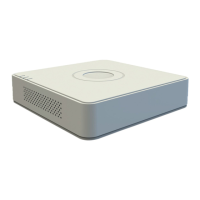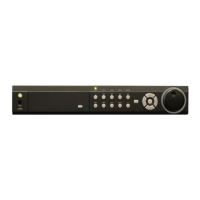
Do you have a question about the HIKVISION DS-7316HGHI-SH and is the answer not in the manual?
Details on FCC compliance for the digital device, including conditions.
Statement on compliance with European directives like WEEE and battery.
Overview of general features like camera connectivity, dual-stream, and encoding.
Features for local display and monitoring, including HDMI/VGA output and screen layouts.
Details on connecting and managing SATA, eSATA, and network HDDs.
Configuration options for recording schedules and modes.
Methods for backing up data, including exporting files and managing backup devices.
Configuration of alarm triggers, response actions, and handling of system exceptions.
Miscellaneous local functions like user management and configuration import/export.
Network interface details, protocols supported, and connection modes.
Information on SDK, source code, and development support for application systems.
Description and illustration of the front panel components for various models.
Instructions on how to operate the DVR using the infrared remote control.
Guide on using a USB mouse for controlling the DVR interface and operations.
Explanation of the soft keyboard icons and their functions for inputting data.
Description and illustration of the rear panel connectors and ports for various models.
Procedure for properly starting up and shutting down the DVR to ensure its longevity.
Step-by-step guide to configuring essential DVR settings using the setup wizard.
Steps to add network cameras to the device for live view and recording.
Overview of the live view function, showing real-time video from cameras.
How to perform various operations within the live view mode using different controls.
Enabling channel-zero encoding to reduce bandwidth for remote viewing of multiple channels.
Customizing live view settings such as output interface, dwell time, and audio output.
Manually diagnosing analog channel video quality and viewing diagnostic results.
Procedure for logging out of the system to return to the live view interface.
Setting up parameters for PTZ control, including RS-485 configuration.
Configuring and using PTZ presets, patrols, and patterns for automated camera movements.
Description of the PTZ control panel icons and their functions for camera manipulation.
Setting video and audio encoding parameters for recording, including stream type and resolution.
Setting up recording schedules for cameras, including daily and holiday schedules.
Configuring motion detection parameters, area, sensitivity, and response actions for triggering recordings.
Configuring the DVR to trigger recording based on alarm input events.
Enabling and disabling manual recording for cameras without a schedule.
Setting up specific recording schedules for holiday periods.
Enabling redundant recording to save files on both R/W and redundant HDDs for data safety.
Grouping HDDs to manage and record specific channels onto particular HDD groups.
Locking recorded files or setting HDD property to Read-only to prevent data overwrite.
Playing back recorded video files using various methods like channel, time, event, or tag.
Utilizing auxiliary playback functions like frame-by-frame, smart search, digital zoom, and reverse playback.
Backing up record files using USB devices via normal video search, event search, or video clips.
Management of backup devices including USB flash drives, HDDs, and USB writers.
Configuring motion detection parameters, area, sensitivity, and response actions for triggering recordings.
Setting up handling methods for external sensor alarms, including arming schedules and PTZ linkage.
Configuring detection of video loss for a channel and setting alarm response actions.
Triggering alarms when the camera lens is covered and configuring response actions.
Setting thresholds for video quality diagnostics and configuring linkage actions.
Configuring response methods for various system exceptions like HDD full or network disconnect.
Configuring actions like full screen monitoring, audible warning, and email alerts upon alarm.
Manually triggering or clearing alarm outputs for testing or specific operational needs.
Configuring basic network settings like working mode, NIC type, IP address, and DNS server.
Configuring advanced network settings including PPPoE, DDNS, NTP, SNMP, NAT, and ports.
Checking network traffic information such as linking status, MTU, and sending/receiving rates.
Configuring network detection for testing delay, packet loss, checking status, and exporting packets.
Procedure for initializing newly installed Hard Disk Drives (HDDs) before they can be used.
Adding and configuring NAS or IP SAN disks as network HDDs for the DVR.
Configuring external eSATA devices for Record or Export use and managing them.
Organizing multiple HDDs into groups for managing and recording specific channels.
Allocating a specific quota for recorded files for each camera to manage storage space.
Checking the status of installed HDDs to identify and address potential HDD failures.
Monitoring HDD health using S.M.A.R.T. (Self-Monitoring, Analysis, and Reporting Technology).
Detecting bad sectors on the HDD to check its overall status and reliability.
Configuring alarms for HDD errors such as Uninitialized or Abnormal status.
Configuring On-screen Display (OSD) settings like date/time, camera name, and display format.
Configuring privacy mask zones to block specific areas from being viewed or recorded.
Adjusting video parameters like brightness, contrast, hue, sharpness, and denoising.
Viewing system information including device, camera, record, network, and HDD status.
Searching and exporting system log files for operations, alarms, and exceptions.
Importing and exporting IP camera configuration details to backup or transfer settings.
Exporting DVR configuration for backup and importing to multiple DVRs for consistent setup.
Upgrading the DVR firmware using local backup device or remote FTP server.
Restoring the DVR to its factory default settings, excluding network parameters.
Configuring RS-232 serial port parameters for device communication or transparent channel.
Configuring general settings like language, output resolution, time zone, and mouse pointer speed.
Configuring Daylight Saving Time (DST) adjustment settings.
Configuring device name, number, CVBS brightness, auto logout, and menu output mode.
Managing user accounts, including adding, deleting, and editing user permissions.
Procedures for logging out, shutting down, or rebooting the DVR device.
Steps to resolve issues where no image is displayed on the monitor after device startup.
Troubleshooting steps for a beep sound indicating potential HDD issues or lack of initialization.
Resolving issues where the live view output is stuck or not real-time due to frame rate.
Troubleshooting audio issues in live view, checking cables and stream settings.
Resolving playback image freezing issues by checking frame rate, hardware, and reducing channels.
Troubleshooting steps when no record files are found, checking time settings, search conditions, and HDD status.










